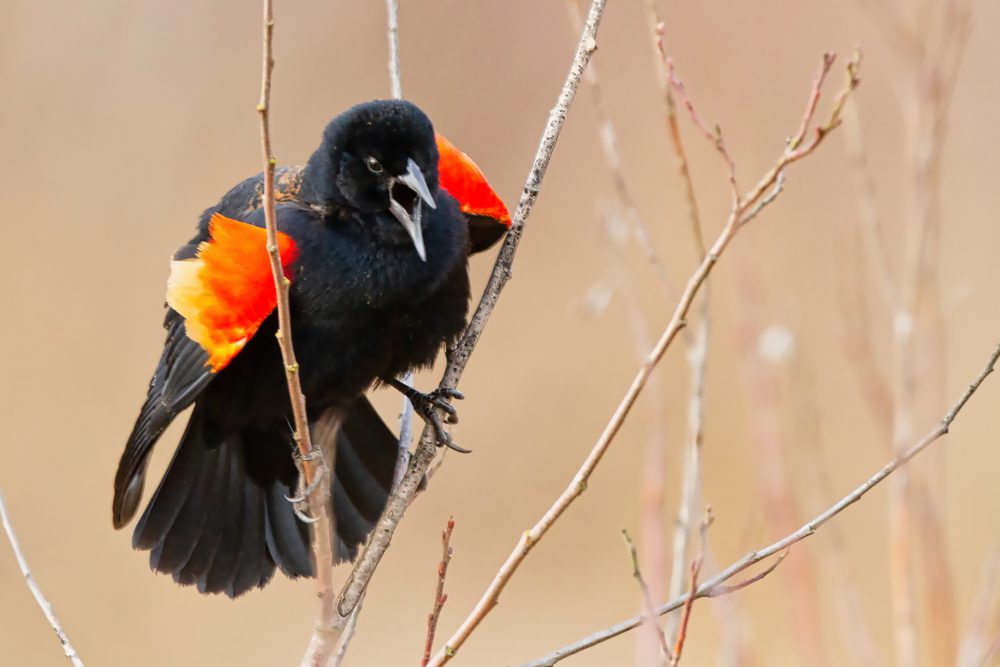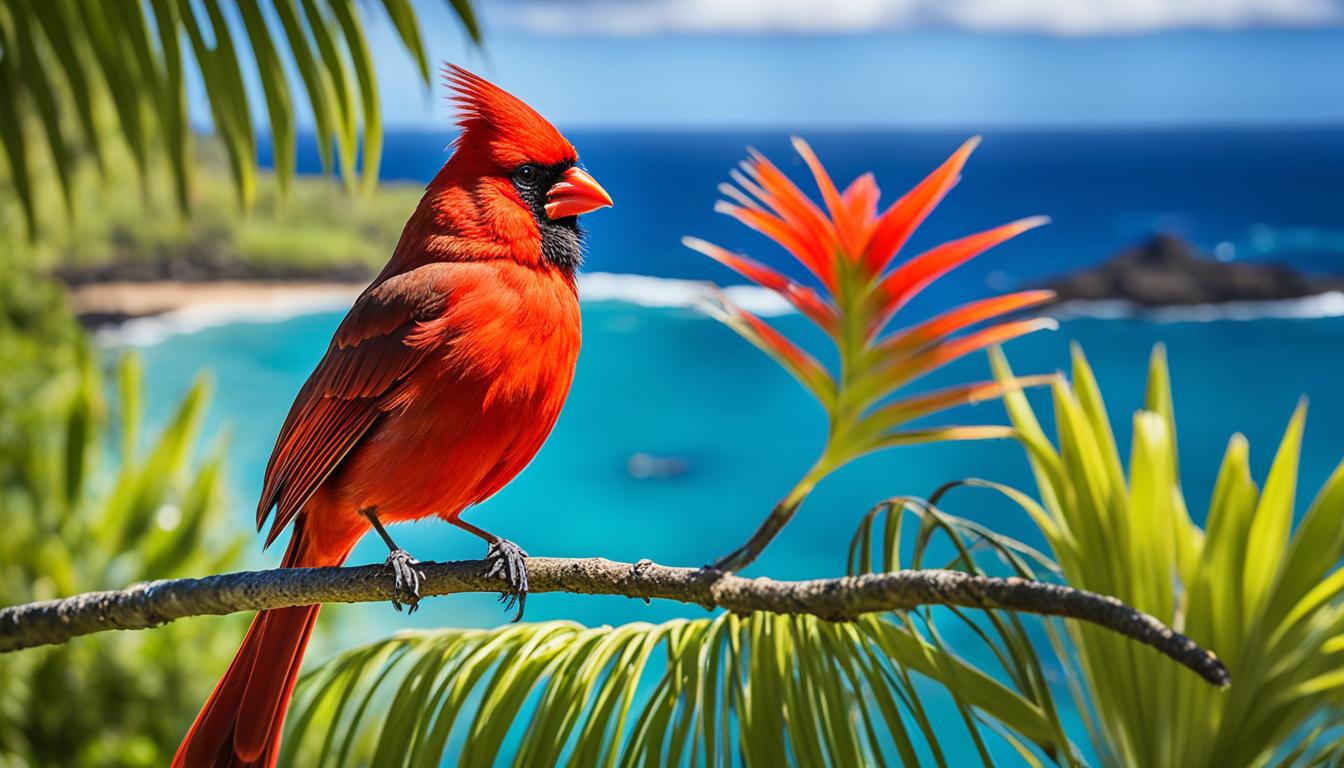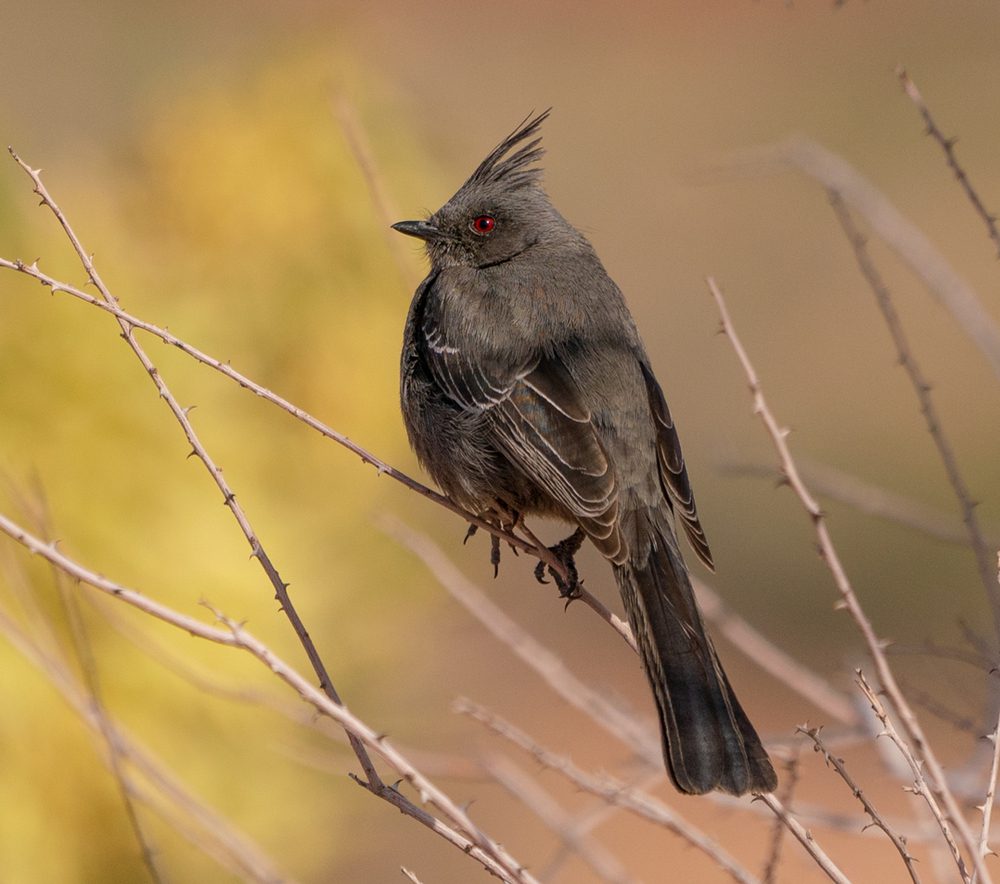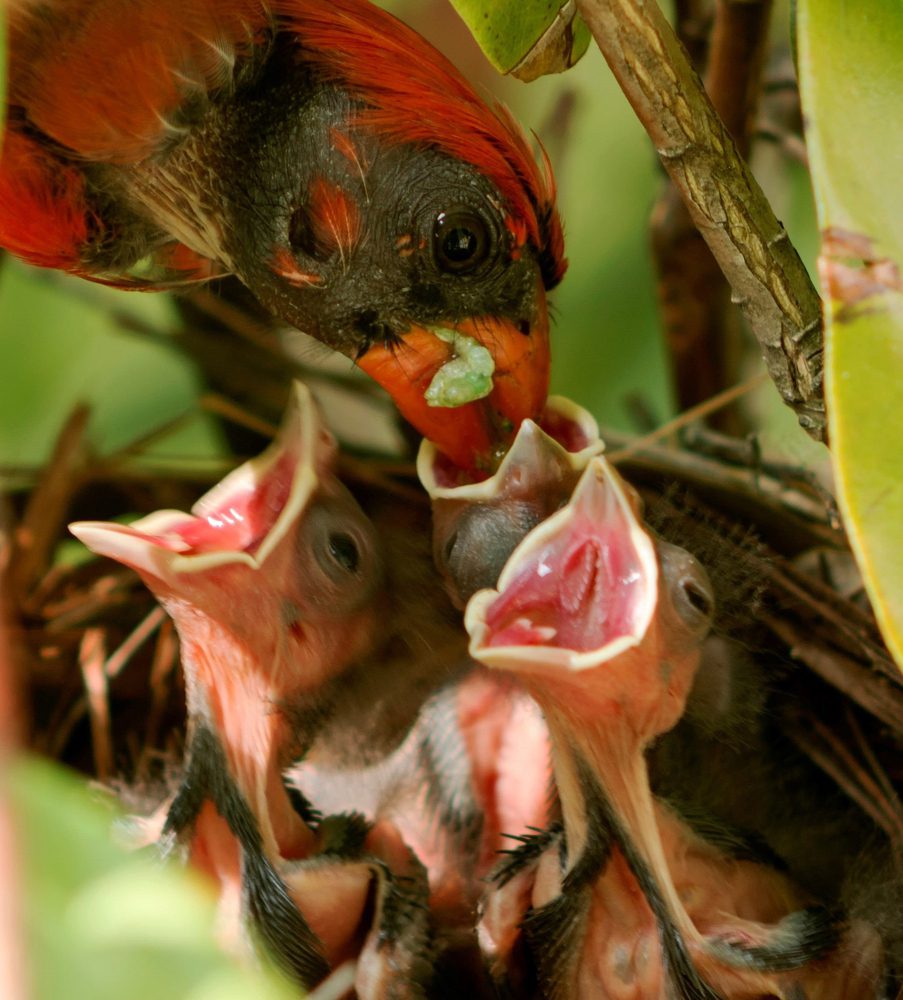Are you interested, in uncovering the lives of red winged blackbird? These captivating creatures, known for their markings and beautiful songs have fascinated birdwatchers and nature enthusiasts. In this guide we will explore the behaviors, habitats and more of these mesmerizing birds. Whether you’re a birder looking to expand your knowledge or simply curious about the wonders of the avian world this blog is perfect for you.
Table of Contents
At a Glance

When examining bird species native to North America [1], the red-winged blackbird stands out with its striking plumage. Adorning each male bird are red shoulder patches which provide delight to those who appreciate nature’s wonders. Within these passages, we will embark on a exploration of the captivating realm inhabited by red-winged blackbirds. Specifically, we will investigate their favored environments, actions, and significant part played in balancing the natural order.
Habitat of Red-winged Blackbirds
Red winged blackbirds inhabit diverse areas across North America—ranging from wetlands and marshes to open fields and farmland. Though thriving in natural settings, they also prosper amid habitats altered by human presence. For nesting purposes, these birds tend to select sites with vegetation like cattails, reeds, or delicate grasses, finding within such concealment and stability for their nests’ construction. Whether amid untouched wilderness or cultivated expanses, their hardworking efforts ensure reproduction within the landscapes now calling them home.
Breeding Season and Behavior
Throughout the spring and into midsummer mating period, male winged blackbirds become very defensive of their spaces. This is when the birds breed. Proudly, the males show off their epaulets to prove their leadership and attract possible partners. Each male strongly guards his selected territory, which can range from a few meters to several hectares in area. Within these boundaries, they seek to ward off other blackbirds.
Nest Building and Parenting
Female red-winged blackbirds take on the primary responsibility of nest construction while the male defends the territory. The female crafts the nest, shaping it into a cup-form built from interwoven grass, leaves, and additional plant materials. Commonly, these nests are built amidst dense greenery situated near water sources. Once the nest is prepared, the female deposits her eggs, typically ranging from 3 to 5 per clutch. Both parents alternate incubating the eggs and feeding the hatchlings after they emerge.
Diet and Feeding Habits
When searching for sustenance, red-winged blackbirds consume a diverse array of nutrients, incorporating insects, seeds, grains and small creatures into their regime. They rummage for victuals by leaping along the land or roosting on flora, frequently hunting insects or grains. Outside of nesting season, red-winged blackbirds also assemble in substantial groups, perhaps to optimize foraging or augment security against threats seeking an easy target.
Migration Patterns
Throughout the year, certain red-winged blackbird groups remain in their nesting territories. However, many flocks embark on seasonal travels. The northern flock, for instance, flies south when winter comes to areas like the southern United States.
Physical Characteristics of Red Winged Blackbirds

Red-winged blackbirds (Agelaius phoeniceus) are notable songbirds visible throughout North America. They can be effortlessly recognized by the brilliant red shoulder patches, referred to as epaulets, on the male birds. Let me share some additional details about their physical features:
Size
On average, male red-winged blackbirds measure around 8 9 inches (20 23 cm) in length, while females are slightly smaller at 7-8 inches (18-20 cm). Males typically weigh between 57-85 grams, while females weigh around 28-57 grams.
Coloration
Gentlemen red-winged blackbirds have shiny black feathers with brilliant red patches on their shoulders. These crimson markings serve as a visual presentation during territorial disagreements and courtship rituals. Ladies, alternatively, have a more subtle appearance, with dim brown feathers and streaking designs for camouflage.
Beak
While foraging for sustenance, red-winged blackbirds leverage their conically shaped beaks to effectively obtain nutrients from an assortment of food sources. Their beaks permit the procurement of insects, seeds, grains, and tiny creatures such as spiders and snails through probing motions on the ground. This specialized pecking tool proves adaptable for the red-winged blackbird’s diet that incorporates both plant and animal matter.
A bird’s beak is an essential tool for finding nourishment from numerous food sources. Its bill is quite robust and sharp, permitting the avians to readily
Sexual Dimorphism
On this particular day in the marsh, I noticed a difference between two red-winged blackbirds. The male bird sported bright red patches on his wings that caught my eye. In contrast, the female lacked this colorful trait. Her wings were simply a dull black. These plumage patterns help tell the birds
Male sandhill cranes use a unique vocalization to serve two important purposes. Their call, a low resonant conk-a-ree sound, aims both to summon potential mates to their territory while simultaneously warning off other males seeking the same. This distinctive noise carries considerable meaning, communicating availability to females while staking a claim against
Habitat and Distribution of Red-winged Blackbirds

Habitat
The Red-winged Blackbird has shown itself to be quite adaptable, found across many regions of North America. It often lives in wetland areas like marshes and swamps, where cattails and other plants provide nesting spots and food is abundant. The bird enjoys wet areas along ponds and lakes too. However, farmland, grassy fields, city parks and even gardens can house it as well. This flexibility has allowed the Red-winged Blackbird to call much of the continent home. Wherever it goes, from wetlands to agricultural zones, it takes advantage of the resources each habitat offers to thrive.
Distribution
The Red-winged Blackbird inhabits much of North America throughout the year. Its range stretches from Alaska and Canada down into Central America. During the nesting period, males of the northern flock may be spotted as far north as the Arctic Circle. As summer emerges, the fowl’s domain widens to envelop the whole northern United States and southern Canada. These fowl migrate modest distances within their domain to locate fitting nesting grounds and foraging. They are renowned for returning to the equivalent nesting areas year after year, establishing territories in their preferred habitat.
Territorial Behavior
As a red-winged blackbird perched watchfully on his lofty lookout post, he sang out his signature call to stake his claim on this patch of wetland domain. Flashing the fiery scarlet epaulets on each wing, he advertised his fitness and mettle to any who dared dispute his dominion. This resolute safeguarding of his borders proved vital for supporting his family aspirations – through such staunch defense alone could he find a fellow to foster future generations, keeping their bloodline flowing in the seasons yet to come.
Influences on Habitat and Distribution
A multitude of elements can influence the environment and whereabouts of Red-winged Blackbirds. Loss of living space due to human endeavors, such as wetland drainage and urban progress, presents a serious risk to the types. Weather change also has a part, affecting the accessibility of fitting nesting locations and adjusting the timing of vital occasions like movement and nesting. Furthermore, the circulation of different winged creature types into Red-winged Blackbird domains can impact their circulation, making new rivalry for assets.
Behavior of Red-winged Blackbirds
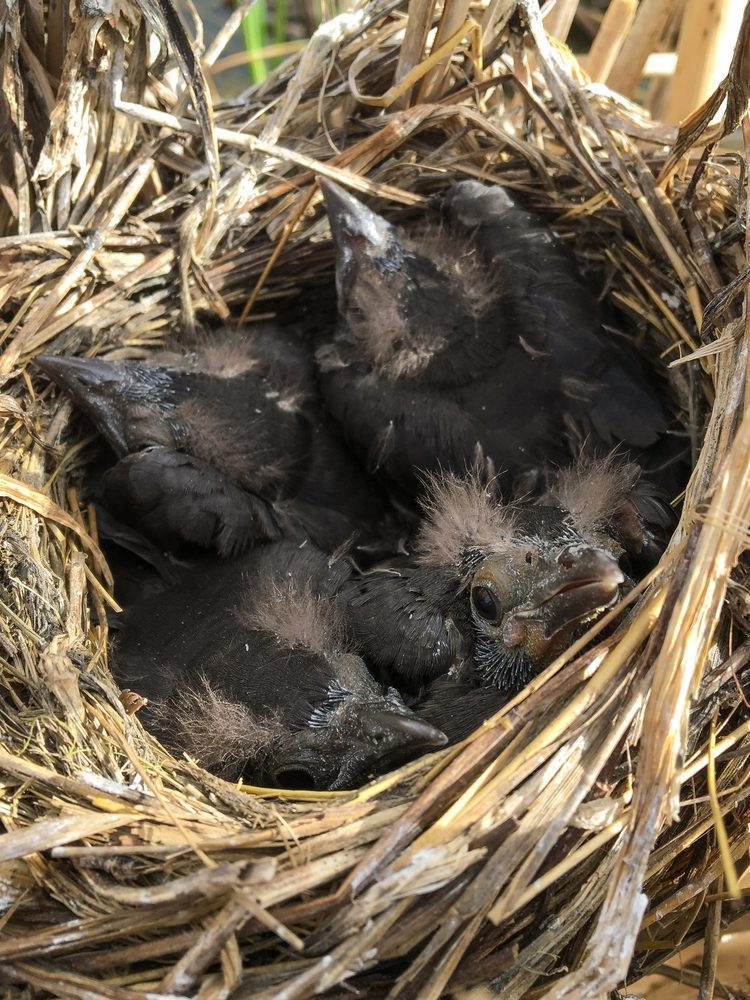
Red-winged Blackbirds are intriguing birds recognized for their varied behaviors and social interactions. Gaining knowledge into their behaviors offers important understandings into their way of life and ecological importance. Herein, we will investigate the behaviors of red-winged blackbirds, accentuating their nesting routines, territorial tendencies, flock associations, and reactions to environmental fluctuations.
Breeding Season and Male Red-winged Blackbirds
Each spring, male red-winged blackbirds took on an important task of securing and safeguarding their spaces. Their brightly colored red shoulder patches, commonly called epaulets, helped these males and potential partners identify one another. Older blackbirds particularly stood out, as their epaulets shone brightest, hinting at their years of expertise and status within the group. These marks proved pivotal as the birds readied their lands and looked for loves during the season of rearing young.
Territoriality and Nest Building
Red-winged blackbirds must assert their claim over lands to safeguard nests and rear offspring. Each male’s chief priority lies in delineating and shielding a range encompassing his nesting site and breeding grounds. They opt for open habitats like marshes, wetlands, and grassy fields, where nest construction occurs amidst tall plants or shrubs nearer the waterline. Crafting nests involves skillfully intertwining fine grasses and plant materials to fashion secure shelters.
Flocking Behavior and Migratory Patterns
During the non-breeding months, red-winged blackbirds often join together in flocks, bringing numerous individuals collectively. The amalgamations vary in quantity, from just a handful to thousands upon thousands of feathered friends. Unity carries advantages such as enhanced searching for food, earlier noticing of threats, and social exchanges. Some red-winged blackbirds take annual trips, with groups from northern parts of North America travelling southward to Central and South America when winter arrives. (Keywords: flocking behaviour, migratory bird).
Response to Environmental Changes
Red-winged blackbirds demonstrate resilience when faced with environmental shifts. Changes to habitat and climate have impacted where and how these birds live. Yet they adapt by altering their homes and behaviors. For instance, in farmlands these blackbirds now nest within crops. There they make use of what the fields offer. Though challenged, red-winged blackbirds survive by exploiting resources wherever they may find them.
Role of Red-winged Blackbirds in Ecosystems

Red-winged blackbirds play a crucial role in ecosystems across North America. Their presence has ripple effects that impact the entire environment, from plant diversity to predator-prey dynamics. Let’s explore their importance in more detail.
Seed Dispersal
Red-winged blackbirds have a penchant for feeding on seeds of various plants. As they move through their habitats, these birds inadvertently aid in the dispersal of seeds. The seeds consumed by blackbirds travel through their digestive tracts and are deposited in different locations through their droppings. This disperses plant seeds over a wider range, contributing to the overall diversity and distribution of plant species.
Insect Control
These striking blackbirds are known for their insectivorous habits. They actively forage for insects, including harmful pests and crop-damaging insects. By preying on these insects, red-winged blackbirds help maintain a natural balance in ecosystems by controlling pest populations. This can alleviate the need for pesticides and promote healthier ecosystems.
Wetland Management
Red-winged blackbirds are commonly found in wetlands and marshy areas. Their constant movement and feeding habits help manage vegetation in these habitats. By consuming plants like cattails and bulrushes, they prevent these species from overwhelming the wetlands and maintain a balance between different plant communities. This promotes a healthier wetland environment for other organisms, such as waterfowl and amphibians.
Indicator Species
Red-winged blackbirds serve as important indicators of habitat health and environmental changes. Their presence and behavior can provide valuable insights into the overall well-being of an ecosystem. For example, declines in their populations may indicate habitat loss or environmental degradation. Monitoring these birds can provide crucial data for conservation efforts and help protect other species that depend on similar habitats.
Cultural Significance
Beyond their ecological significance, red-winged blackbirds hold cultural and symbolic value in many indigenous traditions and folklore. They are often associated with themes of resilience, adaptation, and harmony with nature. By appreciating and learning about these birds, we can deepen our connection to the natural world and foster a sense of stewardship for the ecosystems they inhabit.
Conservation of Red-winged Blackbirds
Protecting the population of Red-winged Blackbirds is essential to maintaining ecological equilibrium and variety in their environments. This story will investigate the different conservation initiatives and obstacles encountered by these memorable North American singing birds.
Threats to Red-winged Blackbirds’ Habitats
The Red-winged Blackbird’s natural habitats, such as wetlands, marshes, and open fields, face significant threats due to habitat loss and degradation caused by human activities. Factors like urbanization, agricultural expansion, and climate change contribute to the loss of suitable nesting and foraging sites for these birds (Keyword: habitat loss).
Preservation and Restoration of Wetland Areas
Red-winged Blackbirds rely heavily on wetlands for their survival. These indispensable habitats serve as breeding sites and provide plentiful food sources. Consequently, conservation efforts aim to safeguard and rehabilitate these crucial wetland ecosystems. Initiatives led by groups such as the National Wildlife Federation work to conserve wetland territories and spread awareness about their worth. Through protecting such locations and enlightening people, they hope to guarantee wetlands continue offering Red-winged Blackbirds the provisions essential for thriving.
Managing Agricultural Landscapes
As agricultural activities have expanded, conservationists have sought to minimize the harmful effects on the environments of Red-winged Blackbirds. By adopting sustainable agricultural techniques like maintaining field borders or growing cover crops, suitable places for foraging and nesting can be made available to these birds in farmland areas. Practices preserving field edges or planting cover crops create appropriate locations for feeding and nesting in agricultural landscapes.
Addressing Climate Change Impacts
For Red-winged Blackbirds, a warming world brings many uncertainties. As our climate shifts, these changes threaten to disrupt crucial resources and nesting grounds. Higher temperatures and varying rainfall could impact food supplies and the conditions needed to raise young. Those working to safeguard these species aim to counter climate change through voices raised in advocacy, policies shaped, and sustainable practices promoted. Their goal – to guarantee survival long into the future, despite the challenges of climatic changes now upon us.
Promoting Public Awareness and Citizen Science
Getting the public involved is essential for effective bird conservation. Individual birdwatchers, community scientists, and neighborhoods can all help track Red-winged Blackbird numbers, pinpoint important nesting and feeding areas, and let others know about any dangers or disruptions. When regular people contribute their observations, it boosts our understanding and protection of these colorful songbirds. Their assistance through birdwatching and reporting what they find aids our goal of keeping red-wings thriving for generations to come.
Collaboration for International Conservation
While red-winged blackbirds mainly live in North America, they also journey to Central and South America during certain periods. To successfully address conservation concerns across their full habitat, worldwide teamwork is essential. By protecting rest stops and safeguarding crucial environments in these regions, we can assist with the more significant ambition of maintaining this kind of bird.
Interesting Facts About Red-winged Blackbirds
The Red-winged Blackbird is an intriguing species with numerous captivating facts. The following details provide some illuminating insights into these fascinating fowl:
1. Tremendous Numbers: Red-winged Blackbirds are one of the most abundant birds in North America. Their population is estimated to be in the tens of millions, making them a common sight in wetlands, marshes, and open fields throughout the continent.
2. Vivid Display: Male Red-winged Blackbirds are renowned for their brilliant red shoulder badges, also termed epaulets. These badges act as a visible demonstration during the breeding year, signifying the male’s territorial possession and pulling in females. The female Red-winged Blackbirds, then again, have a more muted brown and streaky feather covering.
3. Talented Songsters: The red-winged blackbird possesses a beautifully melodic and intricate song that resounds throughout their homes. The males employ their distinctive calls to protect their domains, converse with their companions, and forewarn other fowl of possible dangers.
4. Nest Builders: Female red-winged blackbirds demonstrate remarkable nest-building skills. Using thin blades of grass and other plant materials, they carefully craft cup-shaped structures anchored securely to supporting plants. Though small, these nests are engineering marvels, safely housing eggs and nestlings within. Through diligent construction, the female blackbirds provide shelter for the growth of new life.
5. Gregarious Feathered Friends: Red-winged Blackbirds demonstrate exceptionally social tendencies and frequently assemble into sizable groups outside the nesting phase. These flocks, varying from a handful of birds to many hundreds or even thousands, band together to search for food and rest as a unit, finding security in their numbers.
6. Ecological Significance: Red-winged Blackbirds fulfill an essential role in the environments they live in. They assist with regulating insect numbers, containing pests that harm crops and people. Moreover, their consumption of weed seeds contributes to natural weed regulation.
Red-winged Blackbirds display intriguing behaviors including hawking, where they launch themselves into the air to catch insects on the wing, and mobbing where flocks band together to protect against predators such as hawks or owls. Their coordinated defensive tactics and adept aerial hunting illustrate these songbirds’ resourcefulness.
Key insight: Red-winged Blackbirds are eye-catching birds with their bold red shoulder patches and melodic songs. They are highly common, construct intricate nests, exhibit unique behaviors, and fulfill significant ecological functions.
Red-winged Blackbirds and Other Bird Species
The Red-winged Blackbird is a notable North American songbird when considering bird species. The male bird has a distinguishing feature – vivid red shoulder patches called epaulets. I will examine the intriguing world of Red-winged Blackbirds and how they engage with other bird types. Their interactions provide insight into these blackbirds’ behaviors and relationships with other species. While some birds keep to themselves, Red-winged Blackbirds demonstrate social tendencies through their communications and relationships. Exploring these interactions reveals aspects of how they live and connect in their habitats.
Habitat and Behavior
Across the continent from southern Canada to the southern United States, Red-winged Blackbirds are a frequent sighting. They favor wetland habitats along the lines of marshes, swamps, and meadows with tall grasses, as such areas supply satisfactory nesting spots and an abundant food supply. These environments grant shelter and sustenance crucial for their survival.
Upon the arrival of the breeding season, the male Red-winged Blackbird declares ownership of its open field domain through song and exhibition of its crimson shoulders. Both song and show serve not only to lure mates but also deter possible foes. It is rather a sight to see as they post themselves upon lofty trees or bullrushes, voicing their unique and melodious calls.
Role in Ecosystems
I observed Red-winged Blackbirds carrying out vital duties in their habitats. Their menus feature an assortment of bugs, grains, and tiny critters, positioning them as a pivotal connector in the food web. While searching for food in wetlands, they assist with keeping insect numbers in check and aiding pollination by transporting seeds from the vegetation they eat.
Red-winged Blackbirds play an important role in the ecosystems they inhabit. Within their territories, they coexist with other blackbird species such as Tricolored Blackbirds and Bicolored Blackbirds. This shared land brings diverse bird life together, forming a vibrant avian community. Such interactions promote biodiversity and foster resilient environments capable of withstanding external pressures. Whether through competitive or cooperative dynamics, the presence of Red-winged Blackbirds and their neighbors contributes to ecologically balanced and thriving habitats.
Challenges and Adaptations
Red-winged Blackbirds must overcome various obstacles in their surroundings, such as the loss of living spaces, changes to the climate, and competition from bigger bird kinds. Human behaviors like farming and urban progress have caused the demolition of wetland habitats, diminishing ideal nesting spots for these fowl.
Red-winged Blackbirds have made certain adjustments to adapt to shifting conditions. For example, they may modify their nesting schedules in reaction to fluctuating water levels or deteriorating wetland regions. Some groups have even displayed a propensity to relocate to other fitting habitats when confronting habitat loss.
During their long travels from wintering places like Costa Rica, Red-winged Blackbirds must overcome challenges as migratory birds. These blackbirds make extensive
The Impact of Red-winged Blackbirds on Human Activities
The red-winged blackbird, with its striking red shoulder patches and melodious calls, may be a familiar sight to bird enthusiasts and nature lovers. Beyond their aesthetic appeal and captivating songs, these birds have a significant impact on human activities in various ways. Let’s explore some of the ways in which red-winged blackbirds influence our lives.
1. Agriculture
Blackbirds with crimson wings play an important part in farmland by managing pest groups. Their sustenance comprises of insects, little creatures, and weed seeds, making them useful for cultivators. These winged animals help keep pest numbers in balance, diminishing the need for synthetic pest poisons and advancing maintainable cultivating procedures.
Quote: “Red-winged blackbirds are considered natural pest controllers, helping farmers maintain healthy crops without relying on harmful chemicals” (source: National Wildlife Federation).
2. Wetland Conservation
Red-winged blackbirds depend on marshy regions for making nests and reproducing. By safeguarding and conserving wetland habitats, we help the perseverance of these fowls indirectly. Spotting red-winged blackbirds in wetlands demonstrates the general well-being and diversity of these pivotal ecosystems.
3. Climate Change Indicator
Scientists closely observe the travels and nesting routines of red-winged blackbirds to gain perception into how transforming climatic situations influence feathered creature populations. These red-winged blackbirds serve as a sign types for environmental alternation. Researchers follow the examples of their migrations and reproductive behaviors to comprehend how fluctuating ecological states have an impact on avian communities. Variations in the timing of their movements between ranges or breeding period can deliver important understandings regarding the consequences of climatic change on natural spaces.
4. Ecotourism and Birdwatching
The male red-winged blackbird’s striking plumage and fascinating behaviors capture the attention of avian admirers and nature lovers alike. Birdwatching ecotourism ventures focused on viewing these blackbirds boost nearby communities economically, helping to protect crucial ecosystems and spread understanding of the need to safeguard the natural environments all wildlife depend upon.
Red-winged Blackbirds and Human-Wildlife Conflict
Although red-winged blackbirds provide various advantages, disputes can develop when their numbers collide with human endeavors. A few troubles to reflect on include:
1. Crop Damage
On occasion, colonies of red-winged blackbirds multiply to such a size that they can significantly harm agricultural crops. The widespread utilization of open fields by these fowl for nesting and feeding sometimes brings about fiscal setbacks for growers in some locales.
2. Air Travel Risks
On occasion, sizable flocks of red-winged blackbirds can pose a hazard for aircraft during takeoff and landing. Airports situated close to open fields or wetland habitats that these birds inhabit are susceptible.
Conclusion
In conclusion, the Red-winged Blackbird (Agelaius phoeniceus) is a fascinating North American songbird with its striking red shoulder patches and melodious calls. Throughout this detailed guide, we have explored various aspects of their life, discussing their habitat, behavior, and ecological role. Let’s summarize the key points we’ve covered:
1. Habitat: Red-winged Blackbirds are commonly found across North America, from Canada to Mexico, and even in parts of Central and South America. They thrive in open habitats such as wetlands, marshes, and agricultural areas where they can find an abundant supply of food and suitable nesting sites.
2. Breeding Season: During the breeding season, the male Red-winged Blackbird plays a vital role in establishing and defending its territory. Their iconic red shoulder patches, or epaulets, are used to display dominance and attract mates. They fiercely defend their territory from other males and even larger birds, ensuring the survival of their offspring.
3. Nest Building: Female Red-winged Blackbirds build their nests close to the ground, often incorporating fine grass, cattails, and other plant materials. The careful construction ensures protection for their eggs and nestlings, while the low location provides defense against predators.
4. Behavior: Red-winged Blackbirds are known for their highly social behavior. They form large flocks, especially during the non-breeding season, and communicate through a variety of calls and songs. They also exhibit migratory behavior, with some populations traveling long distances to reach their wintering grounds in Central and South America.
5. Threats and Conservation: Despite their adaptability, Red-winged Blackbirds face various threats, including habitat loss and climate change. Wetland degradation and agricultural development have contributed to the decline of some populations. Conservation efforts, such as wetland restoration and habitat protection, play a crucial role in safeguarding their population.
Key Insight: The Red-winged Blackbird is an iconic and beloved songbird that adds beauty and diversity to North American ecosystems. By understanding their habitat, behavior, and conservation needs, we can work towards preserving these charismatic birds for future generations.
FAQ
Where do red-winged blackbirds live?
Upon examining the avian populace of North America, one readily encounters the Red-winged Blackbird. Native to the continent from southern Canada down through Central America, this wetland-dwelling species favors marshes, swamps, and fields recently deluged with water. While such locales serve as their typical territory, Red-winged Blackbirds have also acclimated to grasslands and areas cultivated by humankind, even making their homes in neighborhoods among our own. Their hardiness and adaptability have allowed proliferation throughout their vast range.
Why are red-winged blackbirds important?
Red-winged blackbirds fulfill an essential function in upholding ecosystem equilibrium. As significant seed dispersers and insect regulators, they aid in controlling populations. Additionally, serving as sustenance for predators while adding to habitat diversity, they contribute to numerous food webs. Moreover, their one-of-a-kind calls and vivid plumage earn them admiration among avian aficionados.
What do red-winged blackbirds eat?
When discussing diet, Red-winged blackbirds are categorized as omnivores. This indicates their meals consist of both plant and animal sources that fluctuate based on the time of year and environment. Some regular sustenance involves insects, seeds, fruits, and grains. Throughout nesting season, small vertebrates and eggs may supplement their routine as well. Generally, these birds explore the ground and tall grasslands seeking nourishment. Occasionally, backyard bird feeders also attract them while provisioning.
What do red-winged blackbirds look like?
I recently observed some colorful feathered creatures with distinct markings. The males had a predominantly jet black form complemented by vivid scarlet shoulder epaulets framed in golden-yellow. Females possessed duller orange shoulder badges. Both sexes featured lengthy tapered beaks and tails that gently swept upwards. These songbirds spanned roughly seven to nine inches from head to tail with wings that stretched twelve to fifteen inches across. Through close inspection, I was able to identify these interesting avians as Red-winged Blackbirds, known for their flashy plumage and pleasant tunes.
How do red-winged blackbirds behave?
Male red-winged blackbirds work diligently to protect the places where their families will grow. Each dawn, you may spot them perched high above the reeds, singing with full voice to invite close companions and dissuade unwelcome strangers. Their winged dances through the air are a sight to behold – zigging and zagging while proudly putting on show their bright red badges of guardianship. When the season calls their offspring near, these fathers feel driven to demonstrate dominance against those who dare disrupt their domains, by enlarging themselves and chasing off interlopers without delay.
What are some interesting facts about red-winged blackbirds?
Male red-winged blackbirds pursue a polygamous lifestyle, taking multiple mates over the course of a breeding season. Renowned for their memorable “conk-la-ree” call that rings out across wetland habitats, these songbirds are fiercely protective of the spaces where they raise their young families.
Come springtime, the marshes and fields reverberate with challenges as rival males compete for domains, ready to rebuff all comers. Omnivorous in diet, red-wings feast on whatever the marsh provides – insects, seeds, grains, and occasionally small fish or frogs. Yet it is the males’ scarlet epaulettes that serve to woo willing partners and warn off would-be usurpers, the flash of color on their wings winning mates and maintaining margins against challengers alike.
Learn More
- Discover Diversity Of Black Birds in Florida
- Top 10 Birds That Are Red And Black
- Discovering Birds With Orange Beak
- 15 Most Common Black Birds in Michigan
- 10 Common Black Birds in Ohio
- 15 Species of Black Birds in Virginia
- The Mystery of Cardinal With Black Head
- Unbelievable Differences Between Female Red-Winged Blackbird vs Sparrow
- What Red-Winged Blackbird Diet [GUIDE]
- The Red-winged Blackbird Migration
- Discover the Astonishing Red-Winged Blackbird Nesting Habits
- Red-winged blackbird symbolism
- red-winged blackbird song
- Top 10 Birds Similar to Red-Winged Blackbird
- how to stop red-winged blackbird attack

